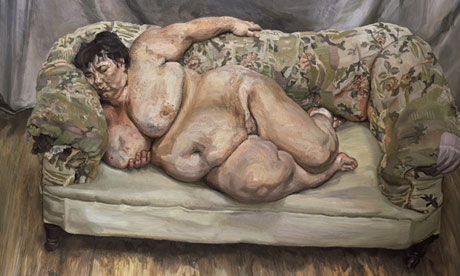A new book argues that the old pristine purity of the nude has been pushed aside by raw and dangerous images of the body. Well, not according to this art buff

The comedy show Seinfeld once had a storyline in which Jerry Seinfeld's girlfriend kept casually walking around his apartment naked. He found this a lot less erotic than he expected. In the coffee shop, he pondered aesthetics.
"There's good naked, and bad naked," he concluded.
This is an issue art critics too have pondered. In the language of art, "good naked" is conveyed by the word "nude", while if you say "naked", you mean "bad naked". The nude is posed, perfect, idealised; the naked is just someone with no clothes on.
The naked is Lucian Freud standing unclothed waving his palette knife about. It is a gathering of models wearing nothing but boots in a photograph by Vanessa Beecroft. These and many more contemporary images of the body feature in a lavishly illustrated new book by art historian Frances Borzello called The Naked Nude.
The title plays on the old antithesis – going back in aesthetic discussions to the 17th and 18th centuries and popularised in the 20th century by the critic Kenneth Clark – between naked and nude or, as Seinfeld put it, bad naked and good naked. Borzello argues that in today's art, the old pristine purity of the nude has been pushed aside by raw and dangerous images of the body. The bland perfection of the classical Apollo Belvedere in the Vatican has been subverted by risky artists of today such as, er, Jenny Saville and, um, Ron Mueck.
Borzello's book is an attractive Christmas present for lovers of art and nakedness, but I am going to make an example of it. It typifies what are becoming the drearily predictable attributes of today's art coffee-table books. First, it crams as much contemporary art in as it can, totally uncritically. Ron Mueck? He's rubbish, but here he is treated as part of a modern pantheon alongside Freud. Coffee-table books that present today's art in this uncritical way do it a disservice by refusing to distinguish bad from good, better from best. They are the equivalent of books in previous generations that may have bored readers by elevating all the old art in museums in the same reverent way.
Got that off my chest – but there's more. Borzello, and again this is typical of a vast swathe of art writing today, sets up a contrast with the past that she does not seek to prove but takes for granted. She confidently declares:
"The representation of the nude in art is a victory of fiction over fact. Its great success has been to distance the unclothed body from any uncomfortably explicit taint of sexuality, eroticism or imperfection."
Really? Is that so? This is student-level art history cliche. A 10-minute walk through the National Gallery at lunchtime would tell you the truth is infinitely more complicated than that. Is Titian's Diana and Actaeon – painted in the 16th century and clearly a summit of nudity/nakedness in western art – a work that distances the unclothed body from sexuality and eroticism? Are you kidding me? As for the Rokeby Venus by Velázquez, painted in the 17th century and another famous nude of the National Gallery, it is so explicitly erotic that a suffragette was once moved to slash the canvas in protest at its exploitative nature.
Another work in the National Gallery, Marriage a la Mode by William Hogarth, shows an 18th-century aristocratic house in which nude art is covered by a curtain. Why such timidity? Because such paintings were always seen as sexy, erotic and dangerous.
And as for the real, fleshy, unidealised human body in art – ever heard of Rubens or Rembrandt?
Borzello's book sets up the entire history of the body in art before modern times as a straw man. Dismissing it all as a sexless fiction, she can then glorify a mixed bag of artists on the spurious grounds that they subvert something called "the nude". But the truth is that nude and naked are just words. Art cannot be contained by them. All nudes always have been naked.
No comments:
Post a Comment